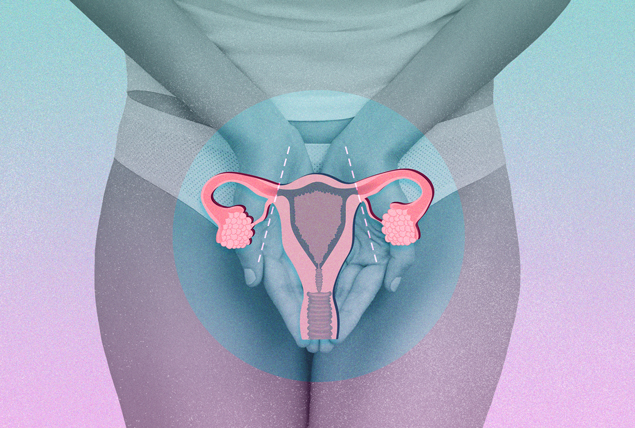Should You Remove Your Fallopian Tubes to Decrease Ovarian Cancer Risk?

Medical experts and organizations have long urged people with a high risk of gynecological cancers–including breast, ovarian, uterine and colorectal malignancies–to undergo the same procedure.
But a new advisory, which reflects a consensus among many health professionals, encourages those at average risk to consider doing so too.
Why is ovarian cancer the deadliest gynecological cancer?
The Ovarian Cancer Research Alliance (OCRA), a major research and advocacy group, recommends more women and people assigned female at birth (AFAB) consider removing their fallopian tubes to reduce the risk of ovarian cancer.
The guidance, included in a new consensus statement, applies to all women with ovaries who do not intend to become pregnant.
Symptoms of ovarian cancer are often vague and mimic those of other conditions.
Ovarian cancer is relatively rare, but it is the deadliest gynecological cancer and the fifth-leading cause of cancer-related death among women and people AFAB, according to OCRA. Approximately 19,710 people in the United States will receive ovarian cancer diagnoses in 2023, and 12,270 will die from the cancer, according to the American Cancer Society (ACH). Fewer than 50 percent of people diagnosed with the disease survive five years.
With many cancers, such as cervical and breast cancers, screening and early detection have been proven to reduce deaths. That isn't the case with ovarian cancer, according to OCRA.
What are current ovarian cancer screening recommendations?
Experts have been working to develop an effective screening strategy for many years, Karen Knudsen, M.B.A., Ph.D., CEO of the American Cancer Society (ACS), said.
However, extensive screening trials have not been successful in proving the effectiveness of combining a blood test for the cancer antigen 125 (CA-125) with a pelvic exam and transvaginal ultrasound as a reliable method for screening ovarian cancer.
In fact, research and clinical guidelines often recommend against screening for ovarian cancer in asymptomatic people as doing so has not been shown to reduce deaths, said Michael Krychman, M.D.C.M., a Newport Beach, California-based OB-GYN and AASECT certified sexual health counselor and supervisor at HerMD. In fact, it can actually cause harm in the form of false positives, according to OCRA.
"The current thinking is that the ovarian cancer screening studies may have shown weak results because they were focused on the ovaries, whereas there is growing acceptance that the ovarian cancers most associated with death, i.e., high-grade serous ovarian cancers (HGSC), arise in the fallopian tubes, not in the ovaries, and later migrate to the ovaries," Knudsen said.
He added that some experts believe alternative approaches may finally lead to the development of an effective screeding process.
"Some researchers are focused on the development of new screening strategies to identify markers from these tiny clusters of abnormal cells or the surrounding tissue to identify the precursors of ovarian cancer early before these cancers progress to the ovaries," Knudsen added.
How are people diagnosed with ovarian cancer now?
As a result, most people are diagnosed after developing symptoms, Knudsen, Krychman and Sharyn Lewin, F.A.C.S., F.A.C.O.G., director of gynecologic oncology at Holy Name Medical Center in Teaneck, New Jersey and Jane Meisel, M.D., an Atlanta-based medical oncologist at Glenn Family Breast Center at Winship Cancer Institute and Medical Director, Cancer Genetics at JScreen, said.
Unfortunately, ovarian cancer symptoms usually don't appear until the disease is advanced, at which point the chances of survival are slim.
To complicate matters further, symptoms—which include bloating, constipation, cramps, feeling full too quickly, difficulty with urination and abdominal or pelvic pain—are often vague and mimic those of other conditions.
"Because symptoms of ovarian cancer are vague, and the tests that we use to screen for the disease are nonspecific, with limited accuracy, it makes the early detection of ovarian cancer difficult," Krychman said.
Does lethal ovarian cancer start in the fallopian tubes?
Lewin and Meisel said the stage at which ovarian cancer is most often diagnosed is stage III, followed by stage IV. Just 21 percent of cases are diagnosed at a localized or early stage, Knudsen said.
Krychman and Knudsen explained that about 70 percent of the most common and lethal ovarian cancers originate in the tip, or outer end, of the fallopian tubes. They then spread to the surface of the ovaries and beyond into the pelvis and abdomen.
"At the time of diagnosis, it is not uncommon for a patient to have pelvic masses, abdominal ascites (copious amounts of fluid in the pelvis), and the CA-125 blood marker to be extremely elevated," Krychman said.
Diagnosis usually involves a CA-125 blood test and transvaginal ultrasound coupled with a pelvic exam followed by a definitive surgery or biopsy, according to Meisel and the American Cancer Society.
Because most ovarian cancers originate in the fallopian tubes, people who have their ovaries removed, but not the fallopian tubes, are still at risk of primary peritoneal cancer, Meisel said. It may be very challenging to treat.
Meisel explained that this cancer looks the same as ovarian cancer under a microscope and responds to the same treatments but has spread or now involves the lining of the inside of the abdomen and lining of the abdominal organs, called the peritoneum.
"These initial cancer cells start in the fallopian tubes and then depending on where the cells ultimately 'land' and start to grow–whether it is on the ovaries, in the fallopian tubes or on the lining of the abdomen or peritoneum–you end up with a cancer that once diagnosed, looks to be primarily involving either the fallopian tube, ovary or peritoneum," Meisel said.
"If you look at clinical trials designed for advanced ovarian cancer, you will notice that virtually all of them include patients with fallopian tube, ovarian, or primary peritoneal carcinoma, as it is all fundamentally the same disease," Meisel added.
Who should consider surgery to remove their fallopian tubes?
Knudsen said a risk-reducing bilateral salpingo-oophorectomy (RRBSO), which involves removing both fallopian tubes and removing the ovaries, is recommended for women at high risk of ovarian cancer who do not wish to become pregnant.
Like breast cancer, the risk factors for ovarian cancer include family history, postponing childbirth until later in life and hormone therapy after menopause.
Women with a family history of gynecological cancers and those with a known or suspected mutation of breast or ovarian susceptibility genes (BRCA1 and BRCA2) are considered high risk.
"It is only recommended in women at high risk due to family history or carrying a known or suspected mutation on breast and ovarian susceptibility genes (BRCA1 & BRCA2)," Knudsen said.
However, she said, an opportunistic salpingectomy, where the fallopian tubes are removed during another gynecological surgery, leaving the ovaries intact, is recommended for people of lower risk. The procedure is deemed "opportunistic" because it is performed on people who are undergoing pelvic surgery for another reason.
How does an opportunistic salpingectomy work?
"Opportunistic salpingectomy is the removal of the fallopian tubes to prevent epithelial ovarian cancer, fallopian tube cancer and peritoneal cancer in a patient at average risk. With greater acceptance that most ovarian cancer arises in the fallopian tubes, removal of the fallopian tubes is regarded as a preventive strategy, and accumulating evidence suggests it substantially, but not entirely, reduces risk of ovarian cancer," Knudsen said.
"In premenopausal women, the ovaries are not removed since oophorectomy results in the loss of ovarian function, which is associated with health risks including heart disease, osteoporosis, early menopause, depression, etc.," Knudsen said.
Meisel said salpingectomy is a "fairly minor surgical procedure" that involves removing at least the outermost third of both fallopian tubes, as this is the area where most cancers and pre-cancerous lesions develop.
In most cases, though, both fallopian tubes are removed completely if possible.
The surgery can be performed alongside pelvic and abdominal surgeries such as hysterectomies for benign reasons like uterine fibroids, tubal ligations for birth control and gallbladder removal.
"Multiple studies have shown that in patients undergoing other surgeries, such as hysterectomies, adding an opportunistic salpingectomy to the procedure does not substantially increase operative time, blood loss, length of hospital stay or surgical complications," Meisel said.
Research indicates opportunistic salpingectomy reduces the risk of ovarian cancer "significantly" by 42 percent to 65 percent, Krychman said.
"All women should have a frank and candid discussion with their healthcare professional about the risks, benefits and possible alternatives to these procedures," Krychman said. If you meet the ovarian cancer risk factors, it's worth talking to your doctor to discuss the right move for you.
Are there other ways to reduce your risk of ovarian cancer?
The risk factors for ovarian cancer are similar to those of breast cancer, Knudsen said, including family history, postponing childbirth until later in life and hormone therapy after menopause. Ovarian cancer incidence also increases with age.
Having children earlier, having multiple children and breastfeeding have a protective effect. Lewin, Meisel and Knudsen said that oral contraceptives and short-term use of intrauterine devices (IUDs) are also associated with lower ovarian cancer risk. Oral contraceptives, specifically, may reduce the risk by 50 percent, Krychman said.
"The mechanism for risk reduction in all of these cases may be related to a decrease in the total number of ovulations in the patient's lifetime," Meisel said.
Experts said there is also some evidence that maintaining a healthy diet and weight can help prevent ovarian and other cancers.
Some experts suggest a tubal ligation, also known as "tube tying"–a permanent, irreversible procedure that permanently blocks the fallopian tubes to prevent pregnancy–might reduce the risk of ovarian cancer as well, Meisel, Knudsen and Krychman said.
"The reason may be that the tubal ligation, or occlusion, prevents the ovaries from exposure to outside environmental factors or toxins, which may increase the risk of ovarian cancer," Krychman explained. "Other cancer experts feel it may be related to the biological or anatomical changes that occur after surgery in the fallopian tubes."
However, Knudsen said the effectiveness varies by cancer subtype, which is consistent with the idea that different kinds of tumors have different origins.
"Of the two strategies, opportunistic salpingectomy is more effective at preventing fallopian tube and ovarian cancers compared to tubal ligation and is not associated with any increase in complications from hysterectomy alone or tubal ligation," Knudsen said.
The bottom line
Ultimately, Krychman said, the best way to potentially reduce the likelihood of developing ovarian cancer is to be aware of the risk. In particular, people with a family history of breast or gynecological cancers can benefit from genetic tests, which OCRA offers for free.
"Finally, always listen to your body," Krychman said. "If you begin to develop any signs or symptoms which are unusual for you, you should be evaluated by a healthcare professional."


















